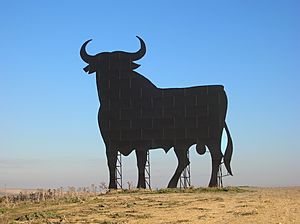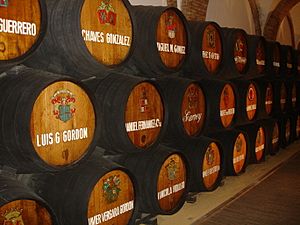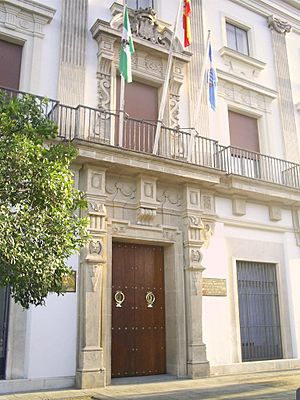Brandy de Jerez facts for kids
Brandy de Jerez is a special type of brandy made in the Jerez area of Andalusia, Spain. It is aged using a unique method called the solera system. This brandy can only be made in the "Sherry Triangle" cities: Jerez de la Frontera, El Puerto de Santa María, and Sanlúcar de Barrameda. Besides being sold on its own, it is also used as an ingredient in some sherries. It has a special official status called a Protected Designation of Origin (PDO). This means its name and quality are protected because of where it comes from.
Contents
History of Brandy de Jerez
Long ago, the Moors lived in the Jerez region. They could not drink the local wines because of their religion. So, they found a way to distill the wines. This process created "alcohol." They used this alcohol to make perfumes and for medical purposes.
It is hard to say exactly when people started aging wine spirits in oak barrels to make brandy. But by the 1500s, a lot of wine spirit was being made. For example, in 1580, the local government in Jerez used money from a wine spirit tax to build a college.
During the 1700s and 1800s, Spain began making more wine spirit for sale. They exported it to other countries, especially in Northern Europe. The Netherlands was a very important market. From there, the spirit was shipped all over the world.
The word "brandy" comes from the Dutch word "brandewijn." This means "burnt wine." The term "holanda" is used for wine spirits with less alcohol. This name comes from Holland, where much of the brandy was sent. In the early 1800s, traders from England, France, and Spain helped develop the way Brandy de Jerez is made and aged today.
In the 1800s, sherry companies started creating brand names for Brandy de Jerez. Many of these brands are still famous today in Spain and around the world.
How Brandy de Jerez is Made
Brandy de Jerez is made using two main types of equipment. Both are made of copper.
- Traditional Alquitara (Pot Still): The Moors first brought these stills to Jerez. They are made of copper and heated directly by a wood fire. This process is done in batches. These stills create spirits with a lower alcohol content, between 40% and 70%. These spirits are called Holandas in Jerez. They are known for their high quality and keep more of the original wine's flavor.
- Modern Distillation Columns: These are newer and more efficient. Wine is put into them continuously. These columns can produce spirits with higher alcohol content, from 70% to 94.8%.
For Brandy de Jerez, the wine does not need to be distilled twice. A single distillation can produce wine spirits around 65% alcohol. Distilling wine too much can make it lose its special flavors and smells.
The way Brandy de Jerez is made is carefully watched by the Consejo Regulador del Brandy de Jerez. This is the Brandy de Jerez Regulatory Council. There are three main rules for making this brandy:
1. The brandy must be produced only in the cities of Jerez de la Frontera, El Puerto de Santa María, and Sanlúcar de Barrameda. 2. It must be aged in American oak barrels. These barrels hold 500 liters and must have held sherry before. Different types of sherry give the brandy slightly different flavors. 3. The traditional aging system called criaderas y soleras must be used. This system mixes older and younger spirits over time.
The Holandas (lower alcohol spirits) must make up at least 50% of the final brandy.
Types of Brandy de Jerez
The Brandy de Jerez Regulatory Council sorts brandy de Jerez into different types based on how long it has been aged:
- Brandy de Jerez Solera: This is the youngest type. It is aged for at least 6 months on average.
- Brandy de Jerez Solera Reserva: This brandy is aged for a minimum average of 1 year.
- Brandy de Jerez Solera Gran Reserva: This is the oldest type. It is aged for at least 3 years on average.
Tourism
"Enotourism" is a new type of travel. It focuses on visiting places where wines and distilled drinks are made. The "Route of Sherry Wine and Brandy de Jerez" has been created for tourists to explore these areas.
Brandy de Jerez in Spanish Cooking
In recent years, Brandy de Jerez has become popular in Spanish cooking. It is often used to flavor dishes, especially with meats.
See also
 In Spanish: Brandy de Jerez para niños
In Spanish: Brandy de Jerez para niños





